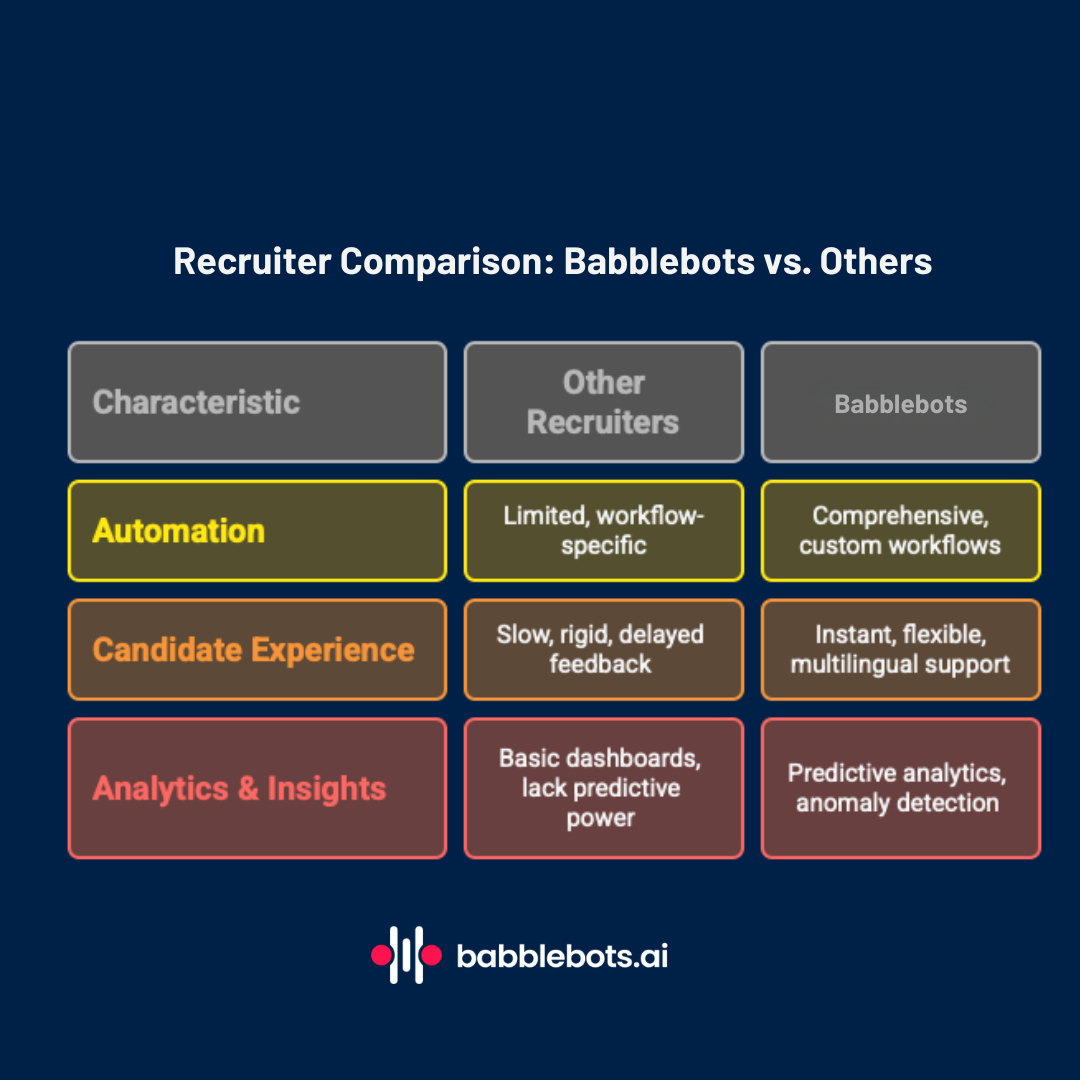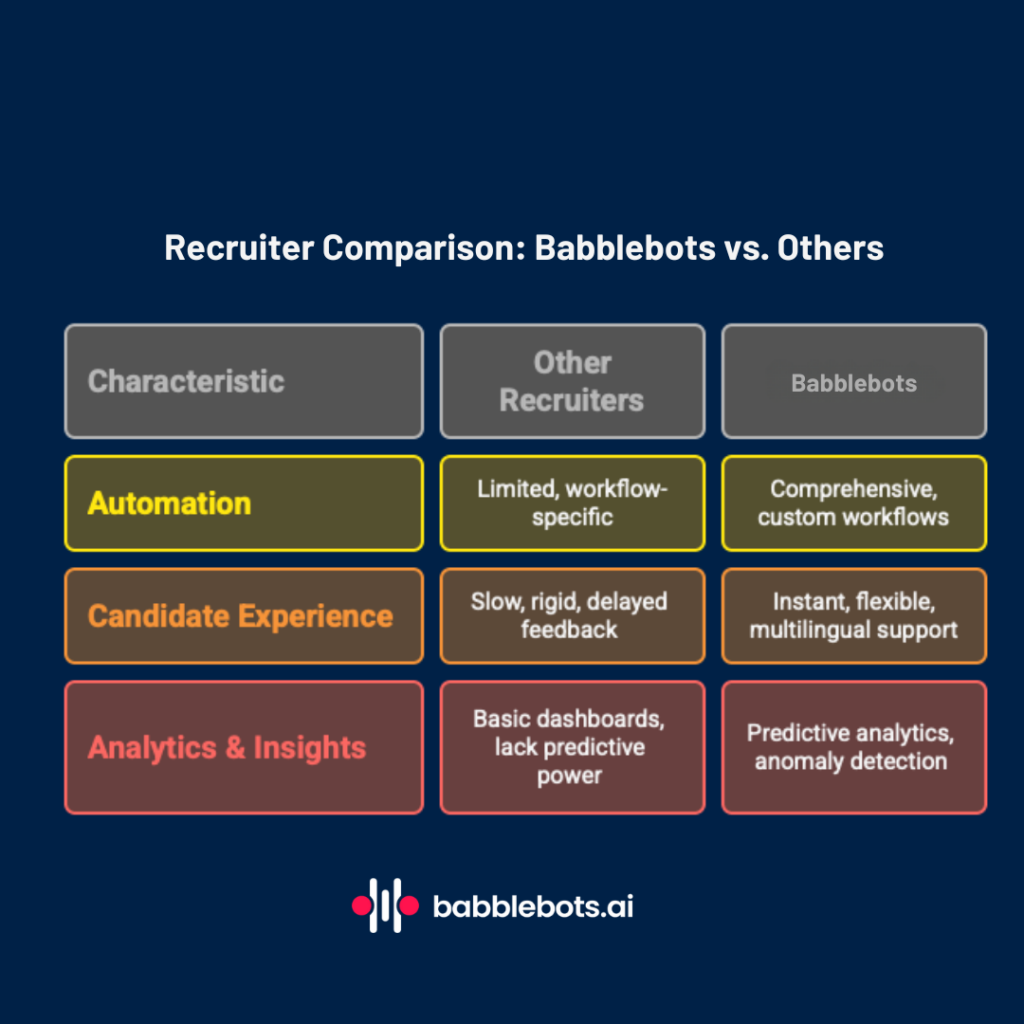AI Recruitment Platforms: Why Babblebots Is the Better Than Others

If you’re exploring AI recruitment platforms, you know they promise speed, efficiency, and automation. However, most fall short. Some stop at video interviews. Others rely on basic chatbots. In addition, many hide key features (like analytics) behind inflated pricing.
On the other hand, Babblebots is different. This equitable AI recruitment platform delivers context-aware resume parsing, voice & video interviews, predictive analytics, and fairness checks helping you hire faster, smarter, and more cost-effectively.
Let’s explore how Babblebots AI compares and why it’s reshaping intelligent hiring.
How Babblebots AI compares with Other Recruitment Platforms
| Feature | Other Platforms | Babblebots AI |
|---|---|---|
| Resume Screening | Keyword filters only | Context-aware parsing with scoring that understands nuance |
| Initial Screening | Manual or inflexible | 24/7 automated voice/video screening with bias-reduced scoring |
| AI-powered Job Description Creation | Limited functionality | Generate JDs instantly with a job title or key skills |
| Interview Types | Video-only | Voice, video, and phone interviews even role-specific question generation |
| Analytics & Insights | Static dashboards | Detailed analytics, funnel dashboards, and proctoring checks |
| Scalability | Small team setups | Small to Enterprise-grade |
| AI-powered Automation | Fragmented or premium-locked | Faster candidate sourcing, CRM workflows, hiring process automation |
| Fairness & DEI | Varies widely; often opaque | Skills-based scoring to reduce unconscious bias |
| Communication | Manual, fragmented | Continuous, multi-channel updates (Email, WhatsApp) to engage candidates |
| Support & Onboarding | Tiered, limited customization | Human-in-the-loop, customizable workflows |
Resume Parsing and Screening in AI Recruitment Platforms
Traditional tools rely on keyword-based parsing. They often fail to identify qualified candidates who use different phrasing. For example, someone with “financial modeling” skills might be missed if the system only looks for “Excel analysis.”
In contrast, Babblebots has an edge. Its context-aware resume parsing reads the substance of a CV, not just keywords. It handles complex formats that most ATS systems miss. Combined with AI scoring, it highlights candidates whose skills align with requirements, even if phrasing varies. As a result, this cuts false negatives and gives you a stronger talent pool.
Initial Screening with AI Recruitment Platforms
The first bottleneck in hiring is initial screening. Talent acquisition teams and recruiters often spend hours shortlisting resumes and then scheduling first interviews.
- By comparison, other platforms offer basic keyword matching or rigid video-screening tools.
- Meanwhile Babblebots automates the entire screening round with:
- 24/7 voice/video interviews powered by AI agents
- Babblebots reduces bias by removing details like name or gender before AI scoring or interviews.
- Custom deal-breaker logic to flag mismatches and identify top candidates early
As a result, hiring teams gain back valuable time and can focus on cultural fit and final-stage evaluations. In fact, early research with HR professionals also suggests that using AI helps save time in hiring and may help improve the candidate experience.
Interview Flexibility with AI Recruitment Platforms
Most platforms stop at video-only. Babblebots offers near-human voice and video interviews with more flexibility.
- Multilingual interviews for local and global hiring
- Voice and conversational AI interviews for quick role assessments
- Video interviews for communication-heavy roles
- Phone interview when required
- AI-generated, role-specific questions
- Coding round or personality tests for a deeper candidate evaluation
Thus, the hiring process adapts to the role, not the other way around.
Analytics & Predictive Insights
Many hiring teams and recruiters struggle with static dashboards only show what happened.
Instead, Babblebots brings predictive analytics into hiring:
- Forecasts candidate success using AI models
- Funnel dashboards that track candidate progress from application to shortlisting in one view
- Anomaly detection to flag unusual patterns (e.g., sudden drop-offs in a stage)
Thus, Babblebots turns hiring data into actionable intelligence that can be used by talent and hiring teams.
Scalability: From Startups to Enterprises
Most platforms serve small teams. Babblebots scales with you:
- Designed for startups growing fast or enterprises with global hiring needs
- Supports multi-role pipelines simultaneously
Therefore, it fits today’s needs and grows with tomorrow’s.
AI Automation That Works Everywhere
Automation is where many AI recruitment platforms fall short. They fragment features across products or lock them behind premium tiers. On the contrary, Babblebots delivers automation out of the box:
- Job Description Automation: AI drafts and optimizes JDs based on the role
- Dynamic interview questions for each role
- Candidate sourcing across job boards
- Standardized assessments for fairness
- Ongoing Candidate Relationship Management via WhatsApp and Email so no talent is lost
Ultimately, this holistic automation makes hiring faster, fairer, and lighter on resources.
Reduced Bias in Hiring
Unlike others, Babblebots promotes equitable hiring outcomes by:
- Removing identifiers like name, gender, or age
- Using Skills-based scoring for fair decisions
- Applying deal-breaker filters only to essentials
As a result, Babblebots aligns hiring with modern workplace values.
Candidate Experience: Always-On Engagement
Today’s candidates expect fast feedback and transparent processes. And Babblebots delivers:
- Anytime, anywhere interviews
- Instant assessment reports
- Personalized multi-channel communication (Email, WhatsApp, AI chatbots)
- Always-on, candidate-first experience
In turn, this builds not just efficient hiring, but a stronger employer brand.
Support & Customization in AI Recruitment Platforms
Unlike rigid platforms, Babblebots provides:
- Dedicated onboarding
- Custom interview flows
- 24/7 AI Recruiters to conduct interviews globally
- A sandbox environment to safely test before deploying
Morever, it integrates with any ATS or HRMS. Even if none exists, Babblebots works smoothly.

Why Companies Choose Babblebots AI Over Other AI Recruitment Platforms
In summary, Babblebots helps companies:
- Hire in days instead of weeks
- Save up to 70% of time per hire
- Deliver a better personalized candidate experience
- Scale instantly across roles
- Gain detailed insights on the candidates
This frees talent teams to focus on what matters – building relationships, assessing cultural fit and team dynamics, and building trust and loyalty with future team members.
Read More
- Learn more in our AI vs Traditional Recruitment guide.
- See how Babblebots transformed IITB DRF’s talent acquisition.
- Find out how Babblebots AI Recruiters helped reduce bias in Hiring.